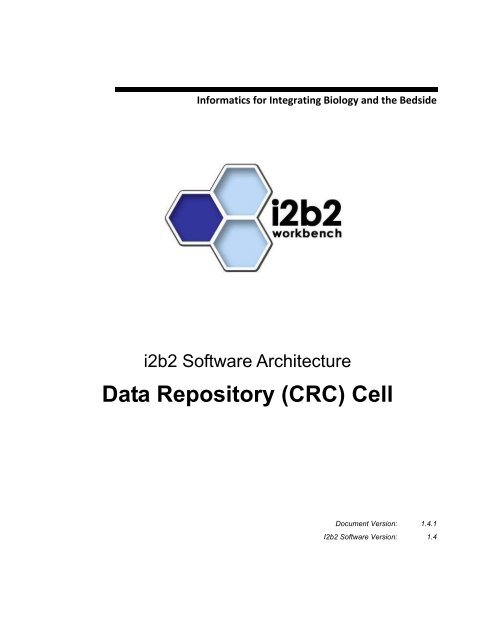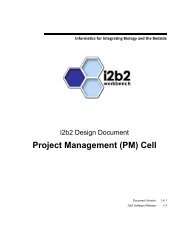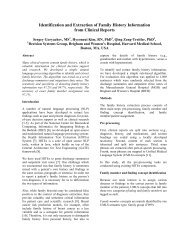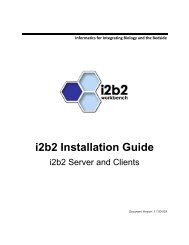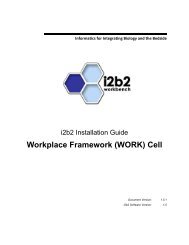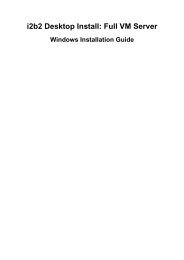Data Repository (CRC) Cell - i2b2
Data Repository (CRC) Cell - i2b2
Data Repository (CRC) Cell - i2b2
You also want an ePaper? Increase the reach of your titles
YUMPU automatically turns print PDFs into web optimized ePapers that Google loves.
Informatics for Integrating Biology and the Bedside<br />
<strong>i2b2</strong> Software Architecture<br />
<strong>Data</strong> <strong>Repository</strong> (<strong>CRC</strong>) <strong>Cell</strong><br />
Document Version: 1.4.1<br />
I2b2 Software Version: 1.4
Table of Contents<br />
Abstract_____________________________________________________________________ 4<br />
1. Overview ________________________________________________________________ 5<br />
1.1 <strong>CRC</strong> Definitions, Acronyms and Abbreviations __________________________________ 5<br />
1.1.1 Patient <strong>Data</strong> Object (PDO): __________________________________________________________5<br />
1.1.2 Setfinder Query: ___________________________________________________________________5<br />
1.1.3 Observation Fact: __________________________________________________________________5<br />
1.2 User Role __________________________________________________________________ 6<br />
1.3 Security ___________________________________________________________________ 7<br />
1.4 Scope of the system __________________________________________________________ 7<br />
1.5 Assumptions/Constraints _____________________________________________________ 7<br />
1.6 Technical Platform __________________________________________________________ 8<br />
1.6.1 Transaction _______________________________________________________________________8<br />
1.6.2 Security__________________________________________________________________________8<br />
1.6.3 Persistence _______________________________________________________________________8<br />
1.6.4 Reliability/Availability ______________________________________________________________9<br />
1.6.5 Performance ______________________________________________________________________9<br />
2. Use Case _______________________________________________________________ 10<br />
2.1 Use Case: Run a Query from Panel Definition___________________________________ 10<br />
2.1.1 <strong>CRC</strong> Query execution using Queue Model: _____________________________________________11<br />
2.1.1.1 Sequence Diagram ____________________________________________________________11<br />
2.1.1.2 Context Diagram _____________________________________________________________11<br />
2.2 Use Case ― Get PDO from PatientSet _________________________________________ 12<br />
3. Architecture Description __________________________________________________ 13<br />
3.1 Components and Connector View _____________________________________________ 13<br />
3.1.1 Client-Server View ________________________________________________________________13<br />
3.1.1.1 Primary Presentation __________________________________________________________13<br />
3.1.1.2 Element Catalog______________________________________________________________14<br />
3.1.1.3 Relations and Their Properties ___________________________________________________15<br />
3.1.1.4 Design Rationale, Constraints ___________________________________________________15<br />
3.2 Module View type __________________________________________________________ 16<br />
3.2.1 Decomposition Style_______________________________________________________________16<br />
3.2.1.1 Primary Presentation __________________________________________________________16<br />
3.2.1.2 Element Catalog______________________________________________________________16<br />
3.2.1.3 Relations and their properties____________________________________________________17<br />
3.2.1.4 Context Diagram _____________________________________________________________17<br />
3.2.2 Uses Style _______________________________________________________________________17<br />
3.2.2.1 Primary Presentation __________________________________________________________17<br />
3.2.2.2 Element Catalog______________________________________________________________18<br />
3.2.2.3 Relations and their properties____________________________________________________18<br />
3.2.2.4 Context Diagram _____________________________________________________________18<br />
3.3 Mappings of Styles _________________________________________________________ 19<br />
Partners HealthCare Systems, Inc Page 2 of 22
4. <strong>Data</strong> View ______________________________________________________________ 20<br />
4.1 Volumes __________________________________________________________________ 20<br />
5. Deployment View ________________________________________________________ 21<br />
5.1 Global Overview ___________________________________________________________ 21<br />
5.2 Detailed deployment model __________________________________________________ 21<br />
References _________________________________________________________________ 22<br />
Partners HealthCare Systems, Inc Page 3 of 22
ABSTRACT<br />
This is a software architecture document for <strong>CRC</strong> (Clinical Research Chart) cell. It identifies<br />
and explains the important architectural elements. This document will serve the needs of<br />
stake holders to understand the system concepts, and give a brief summary of the use of<br />
the <strong>CRC</strong> message format.<br />
Partners HealthCare Systems, Inc Page 4 of 22
1. OVERVIEW<br />
The Clinical Research Chart (<strong>CRC</strong>) repository cell is one of the core cells in the <strong>i2b2</strong><br />
Hive. The <strong>CRC</strong> cell is designed with several requirements. The main requirements are:<br />
1. It must be able to hold healthcare information from many different venues and<br />
allow it to be queried rapidly even if there are hundreds of millions of rows.<br />
2. It must be easily combined with other project repositories to form large unified<br />
repositories.<br />
3. Finally, it must allow objects to be stored that are present in the genomic data.<br />
Currently information in the <strong>CRC</strong> cell is related to clinical data and hence it’s also called<br />
Clinical Research Chart. For the remainder of this document, the terms <strong>CRC</strong> and <strong>Data</strong><br />
<strong>Repository</strong> <strong>Cell</strong> will be used interchangeably to refer to the same cell.<br />
The <strong>CRC</strong> is a data warehouse of patient’s phenotype and genotype information. It is<br />
supported by a powerful metadata management module (the Ontology <strong>Cell</strong>). Currently<br />
the <strong>CRC</strong> handles concepts such as diagnoses, procedures, medications, and lab tests,<br />
but the structure of the table gives enough flexibility to expand this to include virtually<br />
any kind of observation. The presence of both genotype and phenotype information<br />
makes this cell a powerful tool for researchers.<br />
All patient data present in the <strong>CRC</strong> is de-identified; the only exception is the patient<br />
notes from hospitals. These notes are stored in encrypted form, so only users enabled<br />
with an encryption key can view them.<br />
1.1 <strong>CRC</strong> Definitions, Acronyms and Abbreviations<br />
1.1.1 Patient <strong>Data</strong> Object (PDO):<br />
This object mirrors the star schema database model of the data mart. It holds patient<br />
information such as clinical observations, demographics and provider data.<br />
1.1.2 Setfinder Query:<br />
Setfinder queries are used to create a set of patients that satisfy a criteria presented<br />
in the query. The setfinder query is composed of query constraints, a list of panels<br />
and its items.<br />
1.1.3 Observation Fact:<br />
Any observation made on a patient can be stored as fact information in <strong>CRC</strong> data<br />
mart. The user can fetch the fact information via the PDO queries.<br />
Partners HealthCare Systems, Inc Page 5 of 22
1.2 User Role<br />
The <strong>CRC</strong> determines when and how data is presented to a user based on their user<br />
roles, which are specified in the PM <strong>Cell</strong>. Each user will have at least two roles per<br />
user_ID and product_ID combination. These two roles can be further defined as a<br />
<strong>Data</strong> Protection role and a Hive Management role.<br />
The data protection role establishes the detail of data the ser can see while the hive<br />
managment role defines their level of functionality the user has in a project.The<br />
following tables summarize the roles in a hierarchical order of least to most access.<br />
<strong>Data</strong> Protection Track<br />
Role<br />
DATA_OBFSC<br />
DATA_AGG<br />
DATA_LDS<br />
DATA_DEID<br />
DATA_PROT<br />
Access Description<br />
OBFSC = Obfuscated<br />
• The user can see aggregated results that are obfuscated (example: patient<br />
count).<br />
• The user is limited on the number of times they can run the same query within a<br />
specified time period. If the user exceeds the maximum number of times then<br />
their account will be locked and only the Admin user can unlock it.<br />
AGG = Aggregated<br />
• The user can see aggregated results like the patient count.<br />
• The results are not obfuscated and the user is not limited to the number of times<br />
they can run the same query.<br />
LDS = Limited <strong>Data</strong> Set<br />
• The user can see all fields except for those that are encrypted.<br />
• An example of an encrypted field is the blob fields in the fact and dimension<br />
tables.<br />
DEID = De-identified <strong>Data</strong><br />
• The user can see all fields including those that are encrypted.<br />
• An example of an encrypted field is the blob fields in the fact and dimension<br />
tables.<br />
PROT = Protected<br />
• The user can see all data, including the identified data that resides in the Identity<br />
Management <strong>Cell</strong>.<br />
Partners HealthCare Systems, Inc Page 6 of 22
Hive Management Track<br />
Role<br />
USER<br />
MANAGER<br />
Access Description<br />
Can create queries and access them if he/she is the owner of the query.<br />
Can create queries and can access queries created by different users within the project.<br />
ADMIN<br />
Note: Further details regarding roles can be found in the PM_Design_Document.<br />
1.3 Security<br />
Users can accesses the <strong>CRC</strong> with domain-id, project-id, user-id and password<br />
combination, which is authenticated through the Project Management <strong>Cell</strong>. The<br />
implementation detail of Project Management <strong>Cell</strong> is considered out-of scope to this<br />
system context.<br />
Note: Further details regarding the implementation of the Project Management cell can be found<br />
in the PM_Install_Guide.<br />
1.4 Scope of the system<br />
Some other participants, currently outside the scope of <strong>CRC</strong>, are:<br />
• Project Management <strong>Cell</strong><br />
• Ontology <strong>Cell</strong><br />
• edu.harvard.<strong>i2b2</strong>.common<br />
1.5 Assumptions/Constraints<br />
• The data in the <strong>CRC</strong> data mart database will not have identified data. The<br />
exception to this are the patient notes stored inside “OBSERVATION_BLOB”<br />
which will be encrypted.<br />
• The client will make “Patient <strong>Data</strong> Object Query/Request” in multiple requests<br />
if the input list(PatientSet or ObservationSet) is big.<br />
Partners HealthCare Systems, Inc Page 7 of 22
1.6 Technical Platform<br />
The technology used to build the product is as follows<br />
• Java 2 Standard Edition 6.0<br />
• Oracle Server 10g database<br />
• SQLServer 2005<br />
• Xerces2 XML parser<br />
• JBoss Application server version 4.2.2 and higher<br />
• Spring Web Framework 2.0<br />
• Axis2.1 web service (SOAP/REST)<br />
1.6.1 Transaction<br />
The <strong>CRC</strong> system is transactional, leveraging the technical platform capabilities. The<br />
transaction management model of the J2EE platform will be reused intensively.<br />
Note: In the current implementation, to support long running setfinder queries, transaction<br />
management will be manually turned off until the completion of the query.<br />
1.6.2 Security<br />
The application must implement basic security behaviors:<br />
• Authentication: Authenticate using the combination of domain id, project id,<br />
user name and a password.<br />
• Authorization: Based on the user role, the user may access setfinder queries<br />
created by other users, view patient notes,etc..<br />
• Confidentiality: Sensitive data must be encrypted (Patient Notes).<br />
• <strong>Data</strong> integrity: <strong>Data</strong> sent across the network cannot be modified by a tier.<br />
• Auditing: All queries and retrieval of patient data is stored for auditing<br />
purposes.<br />
• User Lockout: Users with the role of DATA_OBFSC will be limited to the<br />
number of times they can run the same query in a project. Once they reach<br />
that limit their account will be locked out and they will not be able to run<br />
queries again until an administrator unlocks the account.<br />
1.6.3 Persistence<br />
Application uses the JDBC calls to persist data.<br />
Partners HealthCare Systems, Inc Page 8 of 22
1.6.4 Reliability/Availability<br />
• The reliability/availability will be addressed through the J2EE platform<br />
• Targeted availability is 16/7: 16 hours a day, 7 days a week<br />
• The time left (8 hours) is reserved for any maintenance activities<br />
1.6.5 Performance<br />
• The user authentication with the project management cell must be under 10<br />
seconds.<br />
• The concept code lookup to the ontology cell must be under 10 seconds.<br />
Partners HealthCare Systems, Inc Page 9 of 22
2. USE CASE<br />
The diagram below depicts the common use cases a user can perform with the <strong>CRC</strong><br />
cell.<br />
runQueryInstanceFro<br />
mQueryDefinition<br />
getQueryMasterList<br />
ByUserId<br />
getPDOByPatientSet<br />
User<br />
getQueryInstanceList<br />
fromQueryMasterId<br />
User<br />
getPDOByVisitSet<br />
renameQueryByMaste<br />
rId<br />
deleteQueryByMaste<br />
rId<br />
2.1 Use Case: Run a Query from Panel Definition<br />
• Validate the user by calling the Project Management <strong>Cell</strong>.<br />
• Select a data mart based on the combination of domain_id, project_id and<br />
user_id.<br />
• Call the Ontology <strong>Cell</strong> with the item key and determine the dimension table<br />
to join with the fact table.<br />
• Save the query panel definition and the generated SQL statements.<br />
• Generate the list of output like the patient count, patient gender count, patient<br />
set, etc.<br />
• To scale the application and to support long running SQL, the execution of<br />
SQL is handled inside a set of queues. At first the query SQL statements will<br />
Partners HealthCare Systems, Inc Page 10 of 22
e executed inside a small job queue, if it didn’t complete within a certain<br />
time period, then the jobs will be transferred to mid size job queue and then<br />
to large size job queue.<br />
• If the SQL execution completes before the “result_waittime_ms” which is<br />
specified in the request, then the query results is passed in the response<br />
message, otherwise the status of the query is passed in the response<br />
message.<br />
2.1.1 <strong>CRC</strong> Query execution using Queue Model:<br />
2.1.1.1 SEQUENCE DIAGRAM<br />
QueryManagerBean queue:QueryExecutor queue:QueryResponse QueryExecutorMDB QueryRequestDAO<br />
QueryMasterDAO<br />
buildSql()<br />
createQueryMaster()<br />
sendQueryRequestMsg()<br />
listenForResponse(timeout)()<br />
Wait for response<br />
until the timout<br />
onMessage()<br />
executeSql()<br />
sendResponseMessage()<br />
queryResponseMessage()<br />
updateQueryStatus()<br />
2.1.1.2 CONTEXT DIAGRAM<br />
Partners HealthCare Systems, Inc Page 11 of 22
SmallJob<br />
Queue<br />
Query<br />
Manager Bean<br />
Query<br />
Message<br />
Mid Job<br />
Queue<br />
Async<br />
Request<br />
Sync<br />
Request<br />
Large Job<br />
Queue<br />
2.2 Use Case ― Get PDO from PatientSet<br />
• Validate the user via the Project Management <strong>Cell</strong><br />
• Select the data mart based on the domain_id, project_id and user_id.<br />
• Call Ontology <strong>Cell</strong> with the item key and determine the dimension table to join<br />
with the fact table.<br />
• Using the given patient set or Observation set, apply the Panel filters and<br />
return PDO.<br />
Partners HealthCare Systems, Inc Page 12 of 22
3. ARCHITECTURE DESCRIPTION<br />
As noted in “Documenting Software Architectures” 0 , software architecture is a complex<br />
entity that cannot be described in a simple one-dimensional fashion. This document<br />
provides the description of the architecture as multiple views. Each view conveys the<br />
different attributes of the architecture.<br />
1. Components and Connector View<br />
a. Client-Server Style<br />
2. Module View<br />
b. Decomposition Style<br />
c. Uses Style<br />
3. <strong>Data</strong> View<br />
4. Deployment View<br />
3.1 Components and Connector View<br />
A Component and Connector view represents the runtime instances and the<br />
protocols of connection between the instances. The connectors represent the<br />
properties such as concurrency, protocols and information flows. The diagram shown<br />
in the Primary Presentation section represents the Component and Connector view<br />
for the multi-user installation. As seen in the diagram, component instances are<br />
shown in more detail with specific connectors drawn in different notations.<br />
3.1.1 Client-Server View<br />
The <strong>CRC</strong> system is represented using the C&C Client-Server view.<br />
3.1.1.1 PRIMARY PRESENTATION<br />
Partners HealthCare Systems, Inc Page 13 of 22
Client<br />
Webservice<br />
Client/<strong>CRC</strong><br />
Navigator<br />
Server<br />
<strong>CRC</strong>Server<br />
Project<br />
Management<br />
Server<br />
Ontology<br />
Server<br />
<strong>CRC</strong><br />
<strong>Data</strong>Mart 1<br />
<strong>CRC</strong><br />
<strong>Data</strong>Mart 2<br />
. . .<br />
<strong>CRC</strong><br />
<strong>Data</strong>Mart N<br />
Key<br />
SQL Full /JDBC<br />
access<br />
SOAP/REST<br />
<strong>Repository</strong><br />
Conponent<br />
3.1.1.2 ELEMENT CATALOG<br />
3.1.1.2.1 Elements and their Properties<br />
The properties of <strong>CRC</strong> cell elements are:<br />
• Element name: given in the following table<br />
• Type: whether the element is a data repository, a data accessor, a<br />
communication method, a query, a client or a server component<br />
• A description of the element<br />
Element Name Type Description<br />
Webservice Client Client Webservice client (<strong>i2b2</strong> Workbench/Navigator) submits the<br />
requests to <strong>CRC</strong> Server components and renders response XML.<br />
<strong>CRC</strong> Server Server Provides Web Service Interface for the <strong>CRC</strong> system. It supports<br />
both SOAP and REST protocols.<br />
Partners HealthCare Systems, Inc Page 14 of 22
It uses Project Management server to handle user authentication.<br />
It uses Ontology server to lookup the concepts metadata.<br />
Select the <strong>CRC</strong> data mart based on domain-id, project-id and userid.<br />
It stores Setfinder query definition, query run instance and the<br />
corresponding query results. The user can then request Patient<br />
<strong>Data</strong> Object using the Setfinder results.<br />
Project Management<br />
Server<br />
Server<br />
<strong>CRC</strong> cell uses the Project Management cell to authenticate the<br />
user. The <strong>CRC</strong> cell constructs PM <strong>Cell</strong> request message and makes<br />
a web service call to Project Management <strong>Cell</strong>.<br />
Ontology Server Server <strong>CRC</strong> sends web service requests to the Ontology cell to get<br />
metadata information about an Observation fact’s concepts.<br />
<strong>CRC</strong> <strong>Data</strong>mart DB<br />
<strong>Data</strong><br />
<strong>Repository</strong><br />
This repository is mainly a data mart for patient’s clinical<br />
observation information represented in star schema. The Server<br />
supports multiple data marts; the data marts are selected based on<br />
the domain_id, project_id and user_id combination.<br />
This database also holds <strong>CRC</strong> user’s queries (setfinder query)<br />
information and its results like patient sets, etc.<br />
Full SQL<br />
Web Service<br />
Query<br />
Connector<br />
Request<br />
Connector<br />
SQL query used as a connector between the <strong>CRC</strong> System and the<br />
<strong>CRC</strong> <strong>Data</strong>mart DB.<br />
SOAP or REST request used to communicate with the external<br />
system.<br />
3.1.1.3 RELATIONS AND THEIR PROPERTIES<br />
The relation of this C&C view is attachment, dictating how components and<br />
connectors are attached to each other. The relations are as shown in the primary<br />
presentation section; there are no additional ones.<br />
3.1.1.4 DESIGN RATIONALE, CONSTRAINTS<br />
N-tier Architecture<br />
The client-server style depicts the n-tier architecture that separates presentation<br />
layer from business logic and data access layer; thus providing for a high degree<br />
of portability through the application of the principle of Separation of Concerns.<br />
Partners HealthCare Systems, Inc Page 15 of 22
3.2 Module View type<br />
The module view shows how the system is decomposed into implementation units<br />
and how the functionality is allocated to these units. The layers show how modules<br />
are encapsulated and structured. The layers represent the “allowed-to-use” relation.<br />
The following sections describe the module view using Decomposition and Uses<br />
Style.<br />
3.2.1 Decomposition Style<br />
The Decomposition view presents the functionality in terms of manageable work<br />
pieces. They can be further decomposed to present higher level of details. The<br />
decomposition view identifies modules and breaks them down into sub-modules and<br />
so on, till a desired level of granularity is achieved. The “Uses” style shows the<br />
relationships between modules and sub-modules. This view is very helpful for<br />
implementation, integration and testing the system.<br />
3.2.1.1 PRIMARY PRESENTATION<br />
System<br />
<strong>CRC</strong><br />
Segment<br />
Setfinder Manager<br />
PDO Manager<br />
3.2.1.2 ELEMENT CATALOG<br />
3.2.1.2.1 Elements and their properties<br />
Element Name Type Description<br />
Setfinder Manager Subsystem This subsystem manages user’s Setfinder queries. Keep tracks of<br />
query information like query definition, its SQL, owner of query,<br />
etc. Also the results of query like the patient set, visit set, etc is<br />
stored.<br />
PDO Manager Subsystem This manages both plain and table Patient <strong>Data</strong> object queries.<br />
Partners HealthCare Systems, Inc Page 16 of 22
3.2.1.3 RELATIONS AND THEIR PROPERTIES<br />
The subsystem elements form the is-part of relation with the overall <strong>CRC</strong><br />
system.<br />
3.2.1.4 CONTEXT DIAGRAM<br />
<strong>CRC</strong> Server<br />
PDO Manager<br />
Setfinder Manager<br />
3.2.2 Uses Style<br />
3.2.2.1 PRIMARY PRESENTATION<br />
System<br />
<strong>CRC</strong><br />
Segment<br />
<strong>CRC</strong> Module<br />
Setfinder Web Service<br />
Setfinder Manager<br />
Subsystem<br />
Setfinder EJB<br />
Setfinder DAO<br />
edu.harvard.<strong>i2b2</strong>.common<br />
PDO Web Service<br />
PDO Manager Subsystem<br />
PDO EJB<br />
PDO DAO<br />
edu.harvard.<strong>i2b2</strong>.common<br />
Partners HealthCare Systems, Inc Page 17 of 22
3.2.2.2 ELEMENT CATALOG<br />
3.2.2.2.1 Elements and their properties<br />
Element Name Type Description<br />
<strong>CRC</strong> Module Module User Login Module authenticates through PIN Server<br />
System with user id and PIN.<br />
Setfinder Webservice Module Provides web service interface to Setfinder operations.<br />
Setfinder EJB Module Delegates Setfinder requests to DAO layer to perform<br />
database operations.<br />
Setfinder DAO Module Supports operation like create query master, delete<br />
query, saving query definition and its results.<br />
PDO Webservice Module Provides web service interface for PDO requests.<br />
PDO EJB Module Module to delegate PDO requests to corresponding PDO<br />
and to build PDO response message.<br />
PDO DAO Module Module to query database based on PDO requests.<br />
edu.harvard.<strong>i2b2</strong>.common Module This module provides utility classes to handle JAXB,<br />
JNDI, etc.<br />
Persistence Service Module Provides SQL interface to database.<br />
3.2.2.3 RELATIONS AND THEIR PROPERTIES<br />
The modules in this style follow a depends-on relation.<br />
3.2.2.4 CONTEXT DIAGRAM<br />
Partners HealthCare Systems, Inc Page 18 of 22
uses<br />
<strong>CRC</strong>Server<br />
uses<br />
PDO Webservice<br />
uses<br />
Setfinder Webservice<br />
uses<br />
uses<br />
Setfinder Manager<br />
uses<br />
edu.harvard.<strong>i2b2</strong>.common<br />
uses<br />
PDO Manager<br />
uses<br />
uses<br />
Setfinder DAO<br />
PDO DAO<br />
3.3 Mappings of Styles<br />
The following table is a mapping between the elements in the Component &<br />
Connector Client-Server view shown in section 4, and the Modules Uses view and<br />
Decomposition view shown in sections 5 and 6.<br />
The relationship shown is is-implemented-by, i.e. the elements from the C&C view<br />
shown at the top of the table are implemented by any selected elements from the<br />
Modules views, denoted by an “X” in the corresponding cell.<br />
<strong>CRC</strong> Server<br />
PM Server<br />
Ontology<br />
Server<br />
<strong>CRC</strong> <strong>Data</strong> Mart<br />
DB<br />
<strong>CRC</strong> Service X X<br />
Setfinder Webservice<br />
PDO Webservice<br />
SetFinderEJB<br />
X<br />
X<br />
X<br />
PDOEJB X X<br />
SetFinderDAO X X<br />
PDODAO<br />
X<br />
Persistence Service<br />
X<br />
Partners HealthCare Systems, Inc Page 19 of 22
4. DATA VIEW<br />
The key data elements related to the <strong>CRC</strong> system are:<br />
«datatype»<br />
SetfinderQuery<br />
«datatype»<br />
PatientSet<br />
1 *<br />
*<br />
1<br />
«datatype»<br />
Patient<br />
«datatype»<br />
ObservationFacts<br />
1 *<br />
4.1 Volumes<br />
• Estimated new setfinder query : 100 a day, with peaks in the morning<br />
• Average PatientSet size 100,000<br />
• <strong>CRC</strong> registered individual user : about 150<br />
Partners HealthCare Systems, Inc Page 20 of 22
5. DEPLOYMENT VIEW<br />
5.1 Global Overview<br />
<strong>Data</strong>base Server<br />
Internet<br />
Webservice<br />
<strong>CRC</strong> Client<br />
WebServer<br />
J2EE Application<br />
Server<br />
PM/Ontology Service<br />
5.2 Detailed deployment model<br />
JBoss Application<br />
Server<br />
<br />
<br />
<br />
crc-webservice.aar crc-EJB.jar crc-server.jar<br />
SQL Server<br />
<strong>Data</strong>base<br />
crc.ear<br />
Oracle<br />
<strong>Data</strong>base<br />
crc-oracle-ds.xml<br />
crc-queryexecutor-mq-service.xml<br />
crc-sqlserver-ds.xml<br />
crc-queryexecutor-sq-service.xml<br />
crc-queryresponse-lq-service.xml<br />
Partners HealthCare Systems, Inc Page 21 of 22
REFERENCES<br />
Clements, P., Bachmann, F., Bass, L., Garlan, D., Ivers, J., Little, R., Nord, R. and<br />
Stafford, J., (2003). Documenting Software architectures – Views and Beyond. Addison<br />
Wesley, Boston, MA.<br />
The “4+1” view model of software architecture, Philippe Kruchten, November 1995,<br />
http://www3.software.ibm.com/ibmdl/pub/software/rational/web/whitepapers/2003/Pbk4p<br />
1.pdf<br />
Object Management Group UML 2.0 Specification -<br />
http://www.omg.org/technology/documents/formal/uml.htm<br />
<strong>i2b2</strong> (Informatics for Integrating Biology and the Bedside)<br />
https://www.<strong>i2b2</strong>.org/resrcs/hive.html<br />
Partners HealthCare Systems, Inc Page 22 of 22


